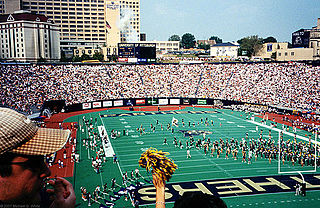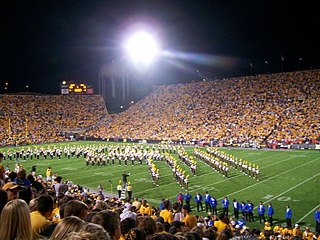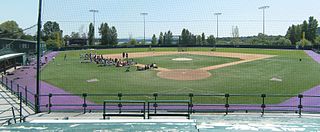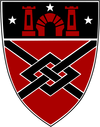
CEFCU ('sef-kyü) Stadium, formerly known as Spartan Stadium, is an outdoor athletic stadium on the west coast of the United States, located in the Spartan Keyes neighborhood of central San Jose, California. Owned by San José State University, the venue is the longtime home of Spartan football; it also hosts the university's commencement ceremony on Memorial Day weekend, and occasional high school football games. Known as Spartan Stadium for over eight decades, it was renamed in 2016.

Pitt Stadium was an outdoor athletic stadium in the eastern United States, located on the campus of the University of Pittsburgh in the Oakland neighborhood of Pittsburgh, Pennsylvania. Opened in 1925, it served primarily as the home of the university's Pittsburgh Panthers football team through 1999. It was also used for other sporting events, including basketball, soccer, baseball, track and field, rifle, and gymnastics.

Kinnick Stadium is a stadium located in Iowa City, Iowa, United States. It is the home stadium of the University of Iowa Hawkeyes football team. Opened in 1929 as Iowa Stadium to replace Iowa Field, it currently holds up to 69,250 people, making it the 7th largest stadium in the Big Ten, and one of the 20 largest university owned stadiums in the nation. Primarily used for college football, the stadium is named for Nile Kinnick, the Iowa player who won the 1939 Heisman Trophy and died in service during World War II. Kinnick Stadium is the only college football stadium named after a Heisman Trophy winner.

Memorial Stadium is a stadium in Bloomington, Indiana, United States. It is primarily used for football, and has been the home of Indiana Hoosiers football since its opening in 1960. It is the 15th largest football stadium in the Big Ten Conference, with a capacity of 52,626. The field has a conventional north-south alignment, at an approximate elevation of 771 feet (235 m) above sea level.

Brigham Field at Huskie Stadium is a college football stadium in the central United States, located on the campus of Northern Illinois University in DeKalb, Illinois. Opened 59 years ago in 1965, it is the home field of the NIU Huskies of the Mid-American Conference (MAC).

Fouts Field was a stadium at the University of North Texas, located in Denton, Texas. Its primary use from its opening in 1952 until 2010 was as the home field for North Texas Mean Green football. Over its 59-year history, Fouts Field was the college home of players such as Joe Greene, Abner Haynes, Steve Ramsey, and Steve Anderson, who would later gain worldwide fame as pro wrestler Steve Austin.

Dix Stadium is a stadium in Kent, Ohio, United States. It is primarily used for American football, and is the home field of the Kent State Golden Flashes football team. In addition, since 2016 the stadium is also home to the Kent State women's soccer team and since 2019 to the women's lacrosse team. Previously, it was home to the Kent State field hockey team from 1997 to 2004 and served as a secondary home for the KSU men's soccer team in the 1970s. It opened on September 13, 1969 and was named in 1973 after Robert C. Dix, former publisher of the Record-Courier and a member of Kent State's Board of Trustees for more than three decades. It was built as an expansion and relocation of Memorial Stadium, with all of Memorial Stadium's main seating areas used at the current stadium in a new configuration. During soccer games, the playing surface is known as Zoeller Field.

Jack Trice Stadium is a stadium located in Ames, Iowa, United States. Primarily used for college football, it is the home field of the Iowa State Cyclones. It is named in honor of Jack Trice, Iowa State's first African American athlete, who died of injuries sustained during a 1923 game against Minnesota. The stadium opened on September 20, 1975, with a 17–12 win over Air Force.

Schoellkopf Field is a 21,500-capacity stadium at Cornell University's Ithaca campus that opened in 1915 and is used for the Cornell Big Red football, sprint football and lacrosse teams. It is located just north of Cascadilla Creek on the southern end of the campus, next to Hoy Field and Lynah Rink; Schoellkopf Memorial Hall, adjacent to the stadium, contains the Robison Hall of Fame Room, the hall of fame for Cornell athletics.

Cessna Stadium is a stadium on the campus of Wichita State University in Wichita, Kansas, United States. It opened in 1946 and served as the home of the football team until the program was discontinued in 1986. It is currently home of the Wichita State Shockers track and field team. The Kansas Board of Regents approved demolition of the stadium in April 2020. Only the east stands were demolished. The rest of the stadium is supposed to be demolished after the 2024 track and field season.

Bobcat Stadium is an outdoor athletic stadium in the western United States, located on the campus of Montana State University in Bozeman, Montana. It is the home of the Montana State Bobcats college football team of the Big Sky Conference.

Ken Riley Field at Bragg Memorial Stadium is a 25,500-seat football stadium in Tallahassee, Florida, United States. It opened in 1957 and was renovated in 1982. It is home to the Florida A&M Rattlers football team.

Saint Francis High School is a Catholic, private college preparatory high school for young men that operates under the administration of Our Lady of the Angels Province of the Order of Friars Minor Conventual in Athol Springs, New York within the Diocese of Buffalo. The school was founded in 1927 by Fr. Justin Figas, OFM Conv. The school is accredited by Middle States Association of Colleges and Schools.

Roos Field is an outdoor college football stadium in the northwest United States, on the campus of Eastern Washington University in Cheney, Washington, southwest of Spokane. It is the home venue of the Eastern Washington Eagles of the Big Sky Conference in Division I (FCS).

Maverick Stadium is a 12,000-seat multi-purpose stadium on the western edge of University of Texas at Arlington campus.

Husky Ballpark is a college baseball park in the Northwestern United States, located on the campus of the University of Washington in Seattle. Opened 26 years ago in 1998, it is the home field of the Washington Huskies of the Pac-12 conference. The playing field was renamed for donor Herb Chaffey in May 2009.
Ross Memorial Park and Alexandre Stadium is a combined multi-purpose outdoor athletic facility in North Franklin Township, Pennsylvania owned by Washington & Jefferson College. The playing surface is made of FieldTurf, like the college's football stadium, Cameron Stadium. At 233,000-square-foot (21,600 m2), the facility was the home of the largest continuous artificial playing surface in the world at its completion in 2004.

Ben Meyer Diamond at Ray E. Didier Field is a baseball venue in Thibodaux, Louisiana, United States. It is home to the Nicholls Colonels baseball team of the NCAA Division I Southland Conference. Opened in 1960, the venue has a capacity of 2,100 spectators. The grandstand features chairback seating and a pressbox. The field is named after Raymond E. Didier, head baseball coach from 1964 to 1973 and athletic director from 1963 to 1978. The diamond is named in honor of Ben Meyer.

Manning Field at John L. Guidry Stadium is a 10,500-seat multi-purpose stadium in Thibodaux, Louisiana. It is home to the Nicholls Colonels football team of the Southland Conference in the Football Championship Subdivision (FCS). The stadium is named in honor of former state representative John L. Guidry who was instrumental in the establishment of Francis T. Nicholls Junior College. The playing surface is named Manning Field after the Manning family because the family holds the annual Manning Passing Academy football camp at the facility. The current playing surface is GeoGreen Replicated Grass. The stadium was officially dedicated on September 16, 1972.

Maverik Stadium, also known as Merlin Olsen Field at Maverik Stadium, is an outdoor college football stadium in Logan, Utah, located on the campus of Utah State University. It is the home of the Utah State Aggies of the Mountain West Conference. The stadium opened in 1968 as "Romney Stadium"























